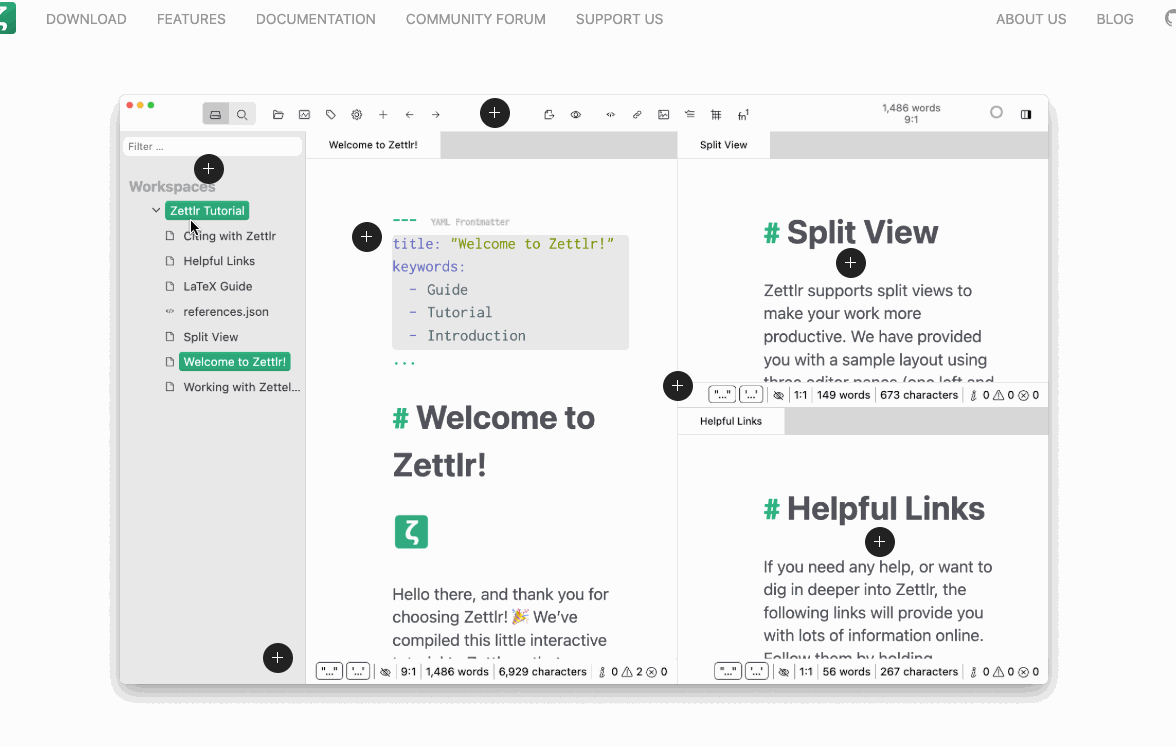John Gruber, the original developer of Markdown, describes it as “a format for writing for the web,” designed to provide a simplified text markup alternative to the complexities of coding HTML. Developed in 2004 by Gruber and Aaron Swartz, Markdown has since become ubiquitous in blogging, instant messaging, forums, collaborative software, and technical documentation.
Unlike word processors, Markdown is written in plain text, with formatting applied using simplified syntax—such as ## for headings or **bold** for emphasis. It supports common text structures like tables, citations, and lists, making it a versatile tool for structured writing. While Markdown variants have emerged—such as GitHub-Flavored Markdown (GFM)—the core syntax remains widely used, particularly in the software development community.
Typical use cases for Markdown include:
- Software Development & Documentation – README files, API docs, GitHub Wiki
- Note-taking & Knowledge Management – Personal wikis, digital notebooks
- Academic & Research Writing – Integration with Pandoc, LaTeX, and reference managers
While Markdown can be written in any plain-text editor—that’s the point!—a growing number of dedicated Markdown applications provide additional features, such as live preview, multiple export options, and syntax highlighting.
Let’s take a closer look at some of the popular Markdown editors available today.
Typora
Typora—billed as “the truly minimal Markdown editor”—delivers a clean, Nordic-inspired interface with generous white space and simple, elegant lines. Its homepage draws users in with sleek animations and rollovers, playfully reworking the familiar WYSIWYG acronym into “What You See is What You Mean.”
Beyond its minimalist aesthetic, Typora is a feature-rich Markdown editor that supports standard Markdown syntax alongside code fences, mathematical notation, diagrams, inline styles, and more. A built-in Themes Gallery—reminiscent of WordPress—offers customization options, while tools for outlining, file organization, import/export, and Focus Mode make it particularly appealing to technical writers and structured content creators.
Originally available as a free beta, Typora now requires a one-time license fee of AU$14.99—an affordable investment for those seeking a distraction-free, flexible, and nicely designed Markdown environment..
Bear
A past winner of an Apple Design Award, Bear is a beautifully crafted note-taking and journaling app that blends seamlessly into the Apple ecosystem. Designed exclusively for macOS and iOS, it offers iCloud synchronization across all your Apple devices, presented in an intuitive and aesthetically pleasing interface.
While Bear supports Markdown-based writing, it leans more toward personal knowledge management than technical documentation. Available as a ‘freemium’ product, the free version provides a well-crafted writing environment, while the Pro version—offering additional features like cross-device sync and themes—is available for a modest AU$2.99 per month or AU$29.99 per year.
- Multi-language support – Supports multiple programming languages for syntax highlighting.
- Elegant, minimalist UI – Clean interface designed for distraction-free writing.
- Tagging system for organization – Uses
#tagsto organize notes instead of traditional folders. - Markdown with rich previews – Allows inline Markdown editing with live preview.
- Cross-device sync – Syncs across macOS, iOS via iCloud.
- Powerful search and linking – Quick search and the ability to create note links (
[[Note Title]]). - Export to multiple formats – Supports PDF, HTML, DOCX, and even JPG.
- Themes & customization – Offers different themes and typography options.
I’ll let this nicely-produced animated promo speak for it:
Mark Text
An MIT licensed open source project, Mark Text leans more toward technical documentation proper than casual note-taking. It is designed for a distraction-free writing experience, providing real-time preview, inline formatting, and full support for advanced Markdown elements like math equations, tables, and code blocks.
Unlike web-based Markdown editors, Mark Text is a local-first application, meaning files are stored on your device, with no internet connection required.
The first thing you’ll notice when launching Mark Text is its simple, elegant interface. The focus is entirely on the content, with a live preview that updates as you type. Whether you’re writing plain text, structured lists, or inserting math equations ($E=mc^2$), everything is formatted as you enter it.
Unlike some Markdown editors that require switching between “edit” and “preview” modes, Mark Text offers a hybrid writing experience, allowing you to see formatting changes as you apply them.
Zettlr
Finally, let’s look at Zettlr, an open-source project that offers truly industrial-strength text editing capabilities. Built on the Electron development framework, Zettlr is billed as a ‘publication workbench’, and is a real Swiss army knife for web text processing, supporting a huge variety of input and output formats via integration with Pandoc. Zettlr operates with folders of text documents to enable organisation of notes, with top-level folders which are opened as Workspaces. Workspaces may include a mixture of files and directories, and files can be exported to over 30 different formats. Zettlr is meticulously and comprehensively documented and supports all the commonly-used academic and industrial formatting conventions, including mathematical and scientific notation.

Feature Wrap
- Typora – Great for general text composition with a minimalist UI and live preview.
- Bear – Ideal for note-taking and journaling, but Mac/iOS only.
- Mark Text – A terrific open-source option for technical writers who need inline scientific and math notation, with real-time preview.
- Zettlr – A powerful tool for academic and structured writing, thanks to Pandoc integration and workspace optimization.
| Feature | Typora | Bear | MarkText | Zettlr |
|---|---|---|---|---|
| Platform | Windows, macOS, Linux | macOS, iOS | Windows, macOS, Linux | Windows, macOS, Linux |
| Open Source | ❌ (Paid) | ❌ (Freemium) | ✅ | ✅ |
| Distraction-Free UI | ✅ | ✅ | ✅ | ✅ |
| Live Preview | ✅ | ✅ | ✅ | ✅ |
| Code Blocks | ✅ | ✅ (Syntax Highlighting) | ✅ | ✅ |
| Math/LaTeX Support | ✅ | ❌ | ✅(KaTeX/MathJax) | ✅ |
| Zettelkasten Note Linking | ❌ | ✅ ([[wikilinks]]) | ❌ | ✅ ([[wikilinks]]) |
| Tagging System | ❌ | ✅ (#tags) | ❌ | ❌ |
| Folder-Based Organization | ❌ | ❌ | ✅ | ✅ (Workspaces) |
| Export Formats | PDF, HTML, DOCX | PDF, HTML, DOCX, JPG | PDF, HTML | PDF, LaTeX, DOCX, HTML…(via Pandoc) |
| Integration with Pandoc | ❌ | ❌ | ❌ | ✅ |
| Cross-Device Sync | ❌ | ✅ (via iCloud) | ❌ | ❌ |
| Price | AU$14.99 one-time | Free / AU$2.99 per month (Pro) | Free | Free |
| Best For | General Markdown writing, clean UI | Note-taking & journaling in Apple ecosystem | Distraction-free Markdown for technical writing | Academic & technical writing with structured organization |
Afterword
Markdown editors fill the gap between plain text and word processing. Unlike traditional word processors, they offer a feature-light, content-focussed approach to writing, making them particularly well-suited for technical and product documentation, note-taking, and academic research.
While all Markdown editors share a common foundation in the Markdown syntax, they differ in focus and features. Some, like Bear, integrate tightly with personal knowledge management workflows, while others, like Zettlr, are built for serious research and publication work.
There are, of course, many more markdown and text editors than can be mentioned here. The Markdown ecosystem is constantly evolving, with new editors appearing and others fading from relevance. When choosing an editor, it’s worth researching how often it’s updated, how active its support forums are, and whether the developers are still engaged with it (GitHub activity often being a reliable indicator).
Ultimately, Markdown’s core strength lies in its portability and simplicity. At the end of the day, a Markdown file is just plain text—editable anywhere, platform-independent, and free from proprietary software constraints. For many writers, that alone is good reason to utilize it.
Intitial publication date March 13 2025



